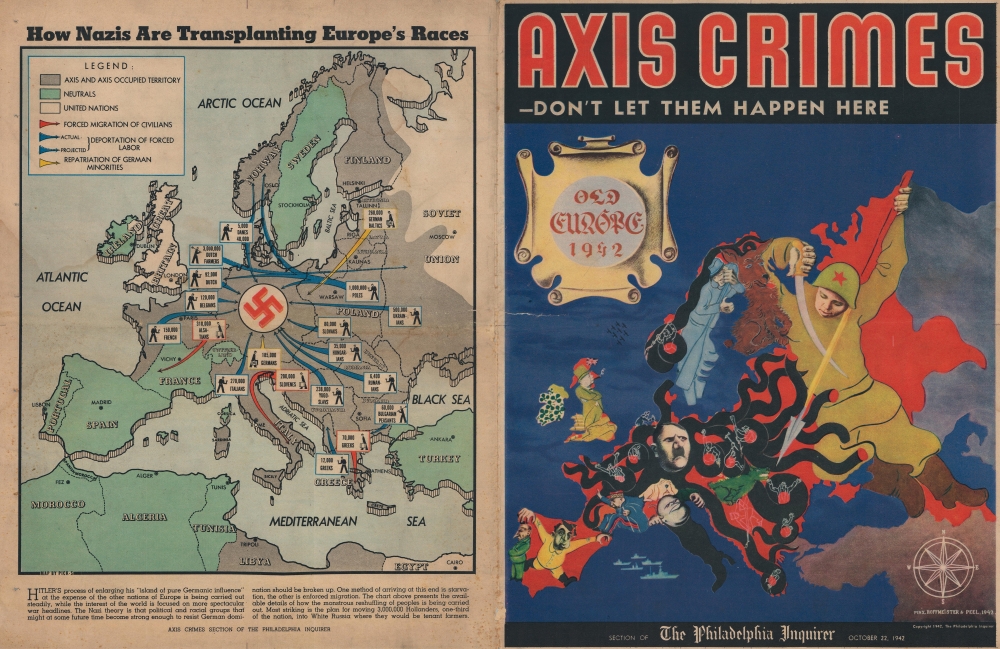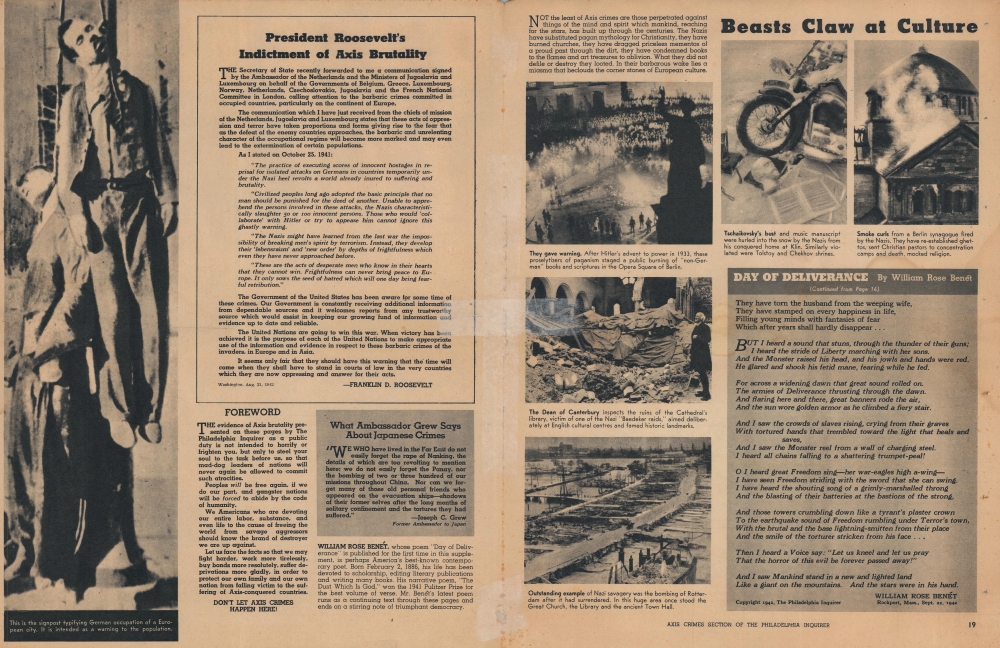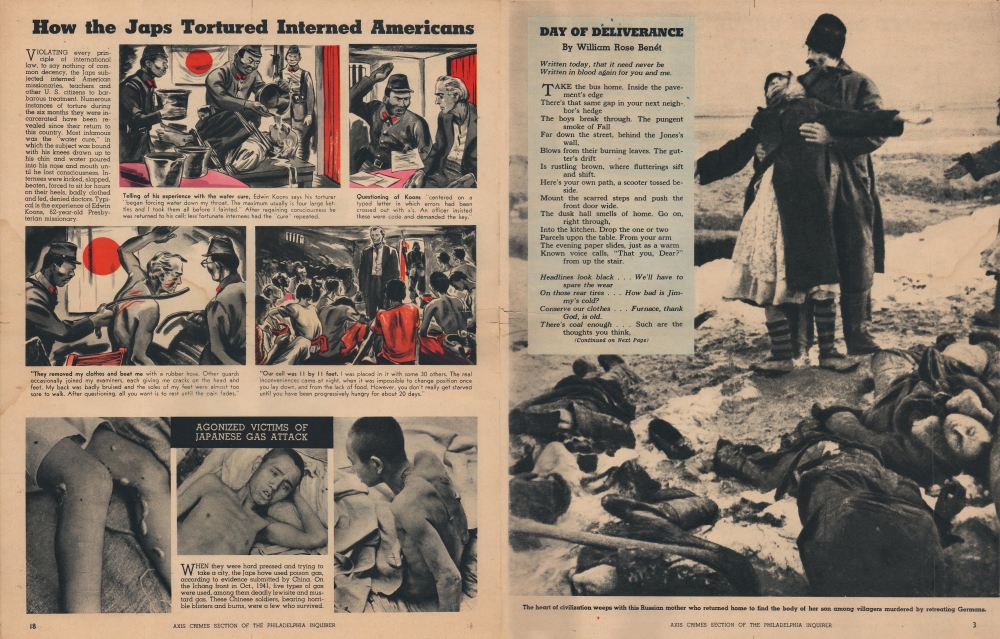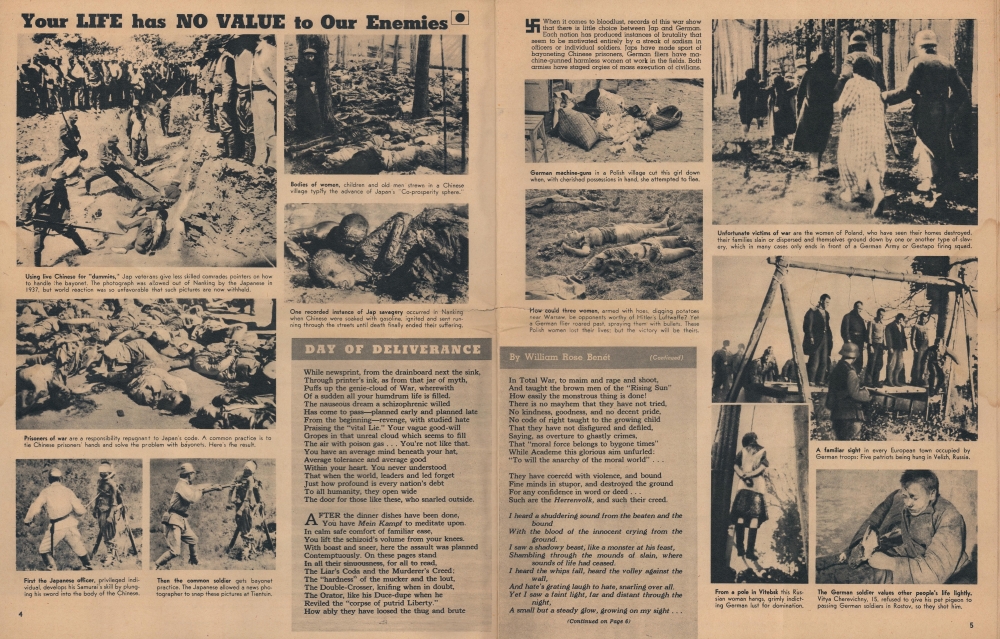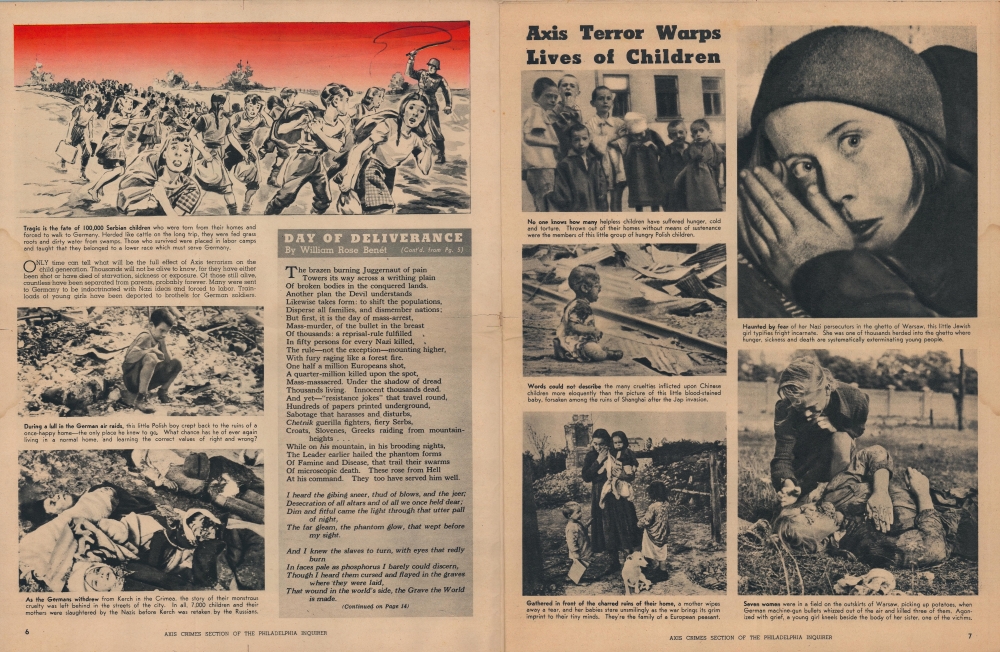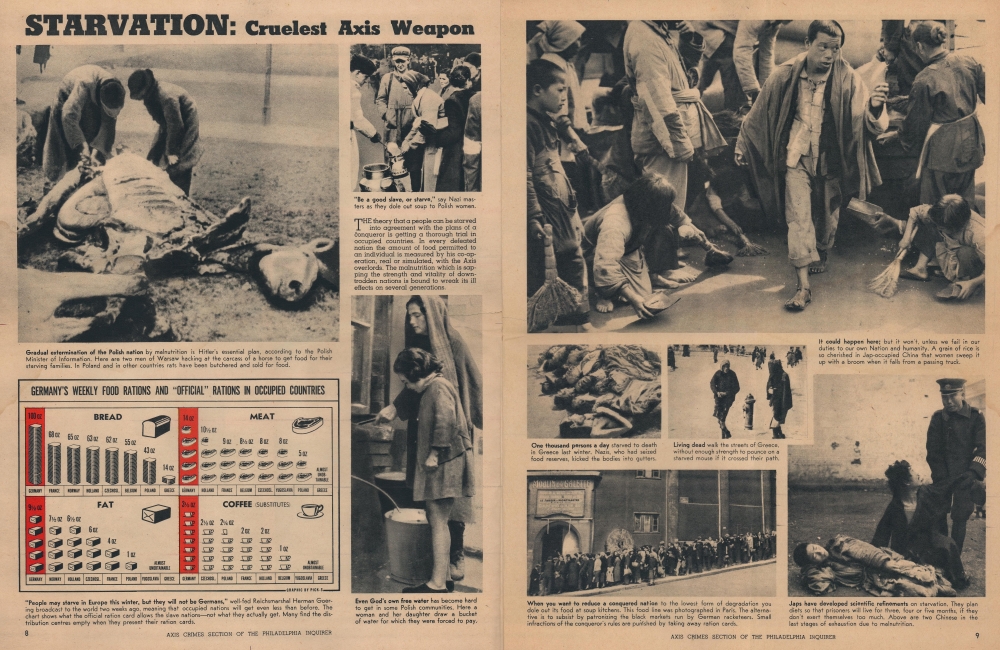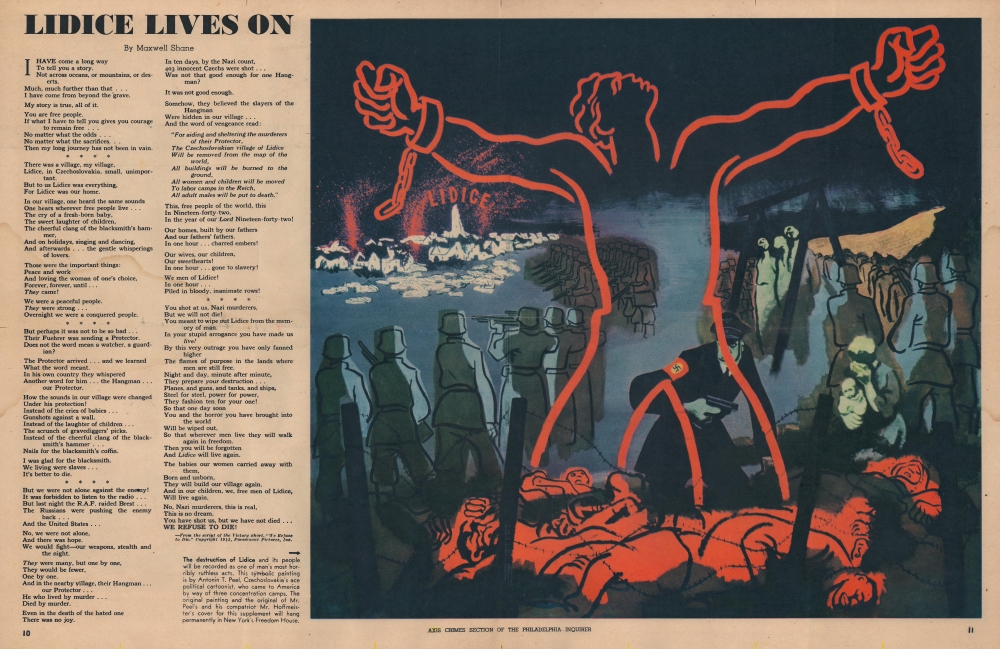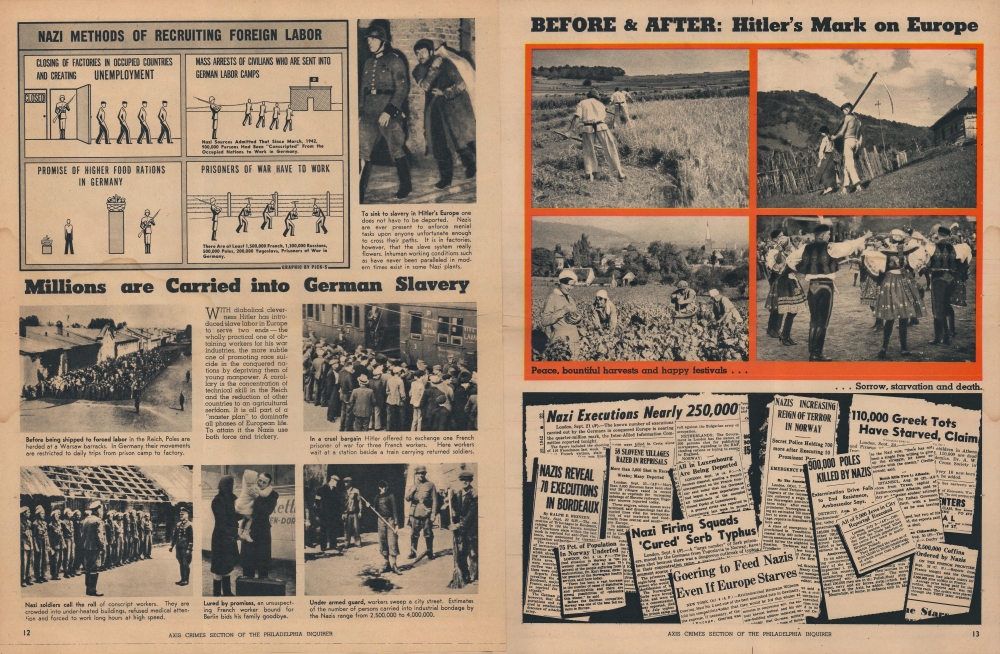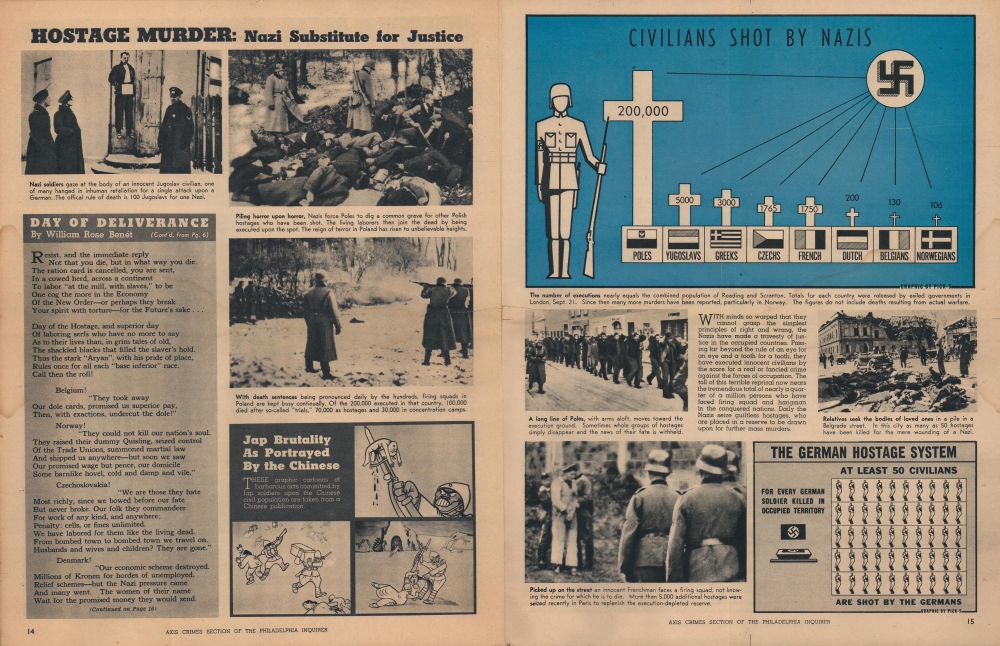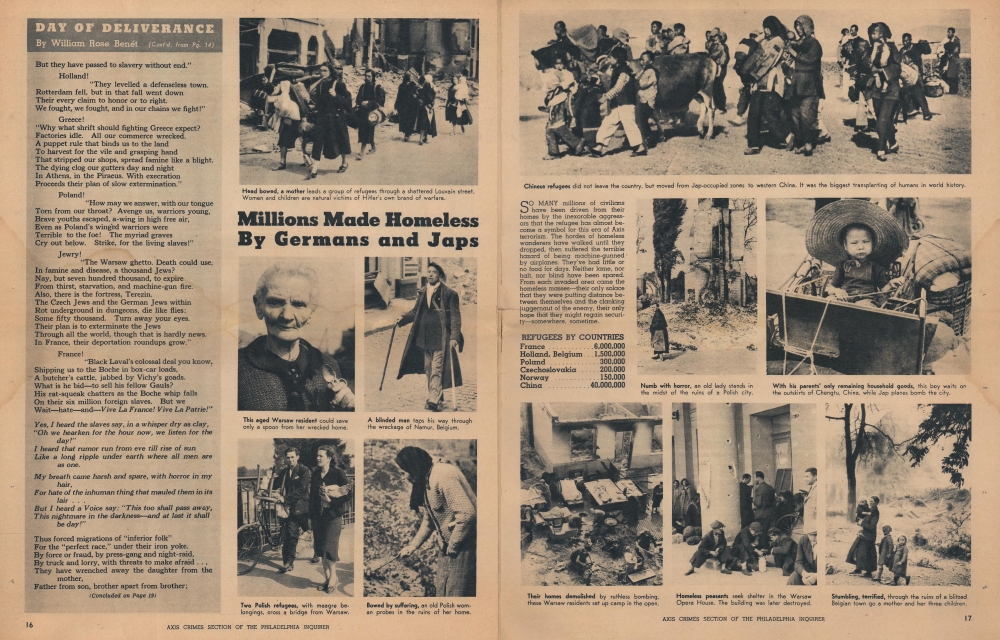
This item below is out of stock, but another example (left) is available. To view the available item, click "Details."
Details
1942 Hoffmeister and Peel (Pelc) Serio-Comic Map of Europe World War II
$650.00
1942 Hoffmeister and Peel (Pelc) Serio-Comic Map of Europe World War II
AxisCrimes-hoffmeisterpeel-1942
Title
1942 (dated) 14 x 21.5 in (35.56 x 54.61 cm)
Description
An Octopus Ensnares Europe
The map octopus was first introduced by Fred Rose to illustrate the menace of Russian imperial ambition. Here it has been reconfigured to reflect Adolph Hitler's Germany. Here, Hitler's mustachioed face sprouts a swarm of pitch-black tentacles reaching into all parts of Europe. The ghosts of conquered nations cry for help or helplessly hack at the invading arms. Russia alone, with spear and sword, defiantly chops away the tentacles of German aggression, painting Europe in blood.The Rest of Europe
Benito Mussolini's portrait appears in northern Italy, while Marshal Philippe Pétain (Nazi collaborator) attempts to control 'Unoccupied' France. Fascist leader Francisco Franco stands over Spain as a puppeteer holding the strings of Antonio de Oliveira Salazar, the Portuguese premier. Winston Churchill embodies the United Kingdom with arms crossed while smoking a cigar. Ireland is covered with shamrocks. In Scandinavia, Norway battles Germany, but Sweden is asleep. Finland (brown dog) turns its back to Sweden while keeping a wary eye on Russia, a reference to the Winter War (1939 - 1940). Switzerland, neutral, appears as a dog.Axis Crimes
The rest of the special section is devoted to Axis Crimes. It features photographs, stories, speeches, and poetry critical of the Axis agenda. A map details forced relocations throughout Europe, with a focus on forced labor sent to German work camps. A table details German-imposed starvation in occupied countries, and an infographic highlights civilian deaths. Photographs from the Warsaw Ghetto appear on page seven and communicate, to a modern viewer, the fact that Americans knew about the horrors of World War II long before V-E Day.Publication History and Census
This map was drawn by Czechoslovak refugees, Adolf Hoffmeister and Antonín Pelc, and published as the front page of the Philadelphia Inquirer's special section: 'Axis Crimes - Don't Let Them Happen Here'. This piece is not cataloged in OCLC, but we note a single cataloged example in private hands.CartographerS
Adolf Hoffmeister (August 15, 1902 - July 24, 1973) was a Czechoslovak caricaturist, illustrator, poet, writer, painter, politician, diplomat, and journalist. Born in Prague under the Austro-Hungarian Empire, Hoffmeister studied at a Real Gymnasium in Prague where he met most of the future members of the avant-garde group Devětsil, which he helped found. He entered the Faculty of Law at Charles University in Prague following graduation and received a doctorate in 1925. He began writing poetry in 1917, first publishing them in magazines under pseudonyms. He continued creating work, writing, and traveling throughout the 1920s and 1930s and had solo exhibitions in Paris and Brussels. During the 1930s, Hoffmeister's caricatures became decidedly antifascist, publishing in the anti-fascist weekly 'Simplicus' with German emigrants forced to flee by the Nazis. When the German Army occupied Czechoslovakia on March 15, 1939, Hoffmeister, a well-known antifascist who had participated in the International Exhibition of Caricature and Humour in 1934, was forced to leave Czechoslovakia. He received a French visa at the insistence of French poet Louis Aragon and founded the Maison de la Culture Tchécoslovaque (House of Czechoslovak Culture in Paris. The Maison became a cultural center and a refuge for Czechoslovak painters, writers, professors, musicians, and journalists in exile. However, in September 1939 after France declared war on Germany following the German invasion of Poland, the police raided the house believing it to be the headquarters of the Czechoslovak Communist Party in exile. Hoffmeister and the other residents were arrested under the suspicion of being enemy spies. After serving a six month sentence in La Santé Prison, Hoffmeister and three other artists (including Antonín Pelc), fled to Casablanca, Morocco. In Morocco, Hoffmeister managed to secure transit to Lisbon, and from Lisbon he made his way to the United States. Hoffmeister spent his first six months in the U.S. with friends in Cleveland and Hollywood before arriving in New York City in December 1941. While in New York, his work was exhibited at the Museum of Modern Art with Antonín Pelc in an exhibition entitled War Caricatures by Hoffmeister and Peel. Hoffmeister returned to Czechoslovakia in June 1945, joined the Communist Party, and became the head of the 6th Department of the Ministry of Information and Education in November. He spent the subsequent twenty-three years creating art and caricatures, writing, and traveling on behalf of the Czechoslovak government. After the failure of the Prague Spring, Hoffmeister fled to Paris, where he spent two years working as a professor at the Université de Vincennes. He returned to Prague in 1970, and was summarily expelled from the Communist Party and banned from all public, publishing, and exhibition activities. He died of a heart attack on July 24, 1973. More by this mapmaker...
Antonín Pelc (January 16, 1895 - March 24, 1967) was a Czechoslovak caricaturist, illustrator, and painter. Born in Lišany, Pelc studied painting at the Prague Academy in the studio of Max Pirner and Vlaho Bukovac. Pelc became a well-known antifascist artist and participated in the 1934 International Exhibition of Caricature and Humour in Prague. The German ambassador protested against and asked for the removal of the most violent anti-Nazi pieces, many of which were created by Pelc. In April 1939, after Germany invaded Czechoslovakia, Pelc, Adolf Hoffmeister (1902 - 1973), and other Czechoslovak antifascists fled to Paris. In Paris, Hoffmeister founded the Maison de la Culture Tchécoslovaque (House of Czechoslovak Culture in Paris. The Maison became a cultural center and a refuge for Czechoslovak painters, writers, professors, musicians, and journalists in exile. However, in September 1939 after France declared war on Germany following the German invasion of Poland, the police raided the house believing it to be the headquarters of the Czechoslovak Communist Party in exile. Pelc, Hoffmeister, and all the other residents of the house were arrested and imprisoned on charges of being enemy spies. After serving six months in La Santé Prison, Pelc, Hoffmeister, and two other artists made their way to Casablanca, Morocco, where Pelc was interned as an unwanted alien. Eventually Pelc and the other artists secured passage to Martinique, and from their Pelc made his way to New York City. In 1946 Pelc recalled of his arrival in New York, 'When we reached the United States, we saw America as a paradise after all that time running from jail to jail and from camp to camp. I was so happy finally to be left alone that I started to paint and draw immediately'. After a year, Pelc restarted working on propaganda and political caricature, publishing work in the Czechoslovak newspaper in New York and other publications. He created propaganda posters for the Czechoslovak Relief Committee and the United Czechoslovak Relief, among several other organizations. In 1943 Pelc (as Peel) and Hoffmeister exhibited their work at the Museum of Modern Art in an exhibition entitled War Caricatures by Hoffmeister and Peel. After the war, Pelc returned to Prague and joined the Communist Party. He was appointed a professor of illustration at the School of Applied Arts in Prague in 1946 and became a professor at the Academy of Fine Arts in Prague in 1955. In his later years Pelc devoted himself to painting, with much of his later work influenced by cubism. Learn More...

